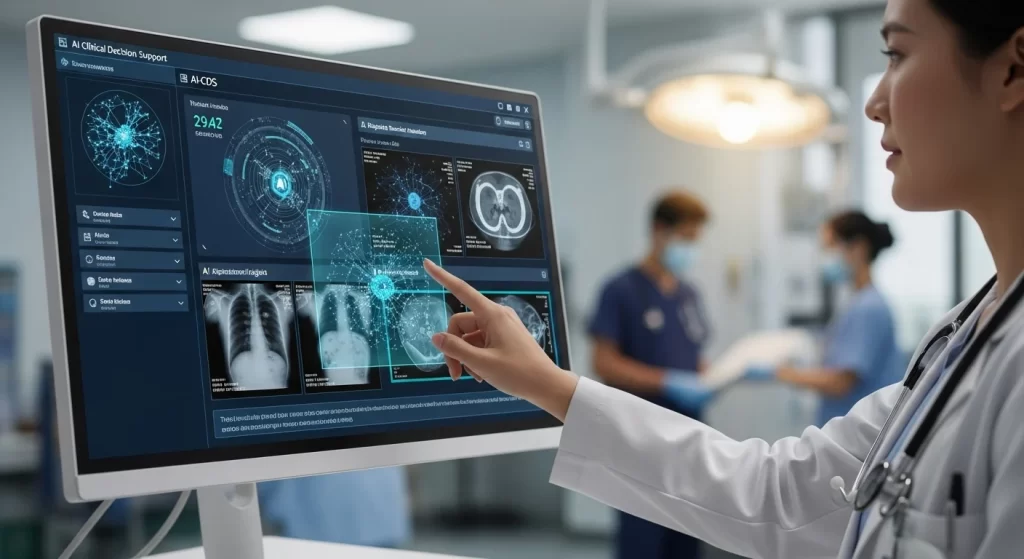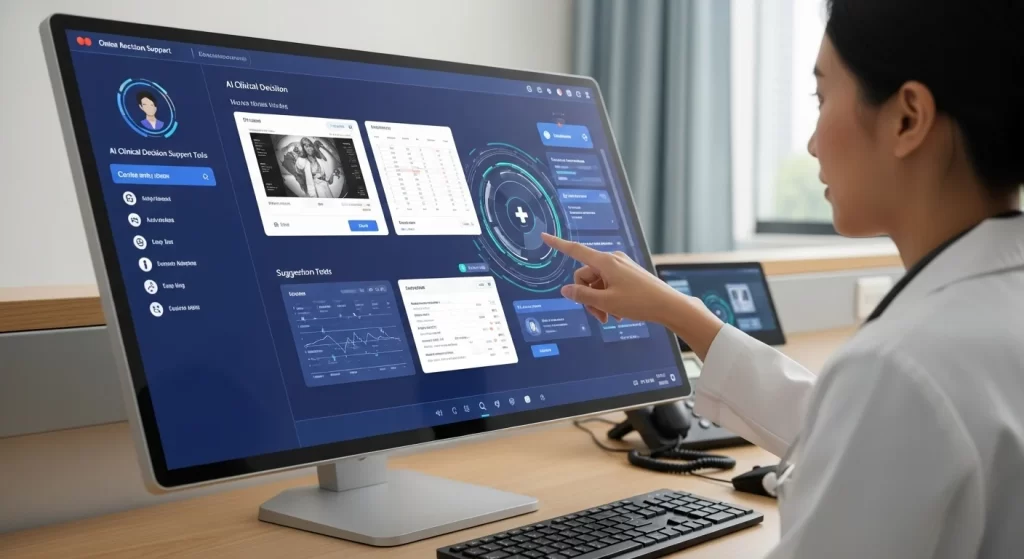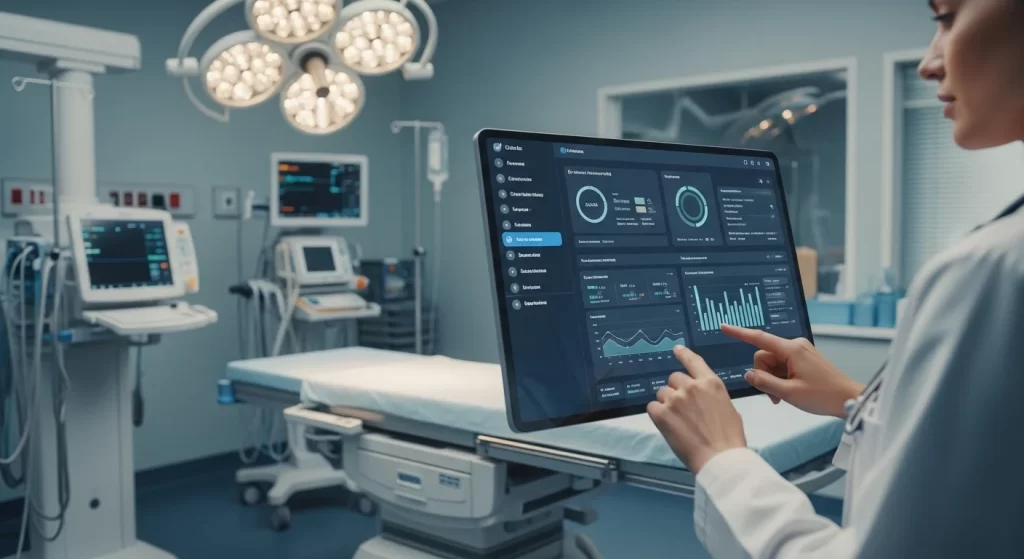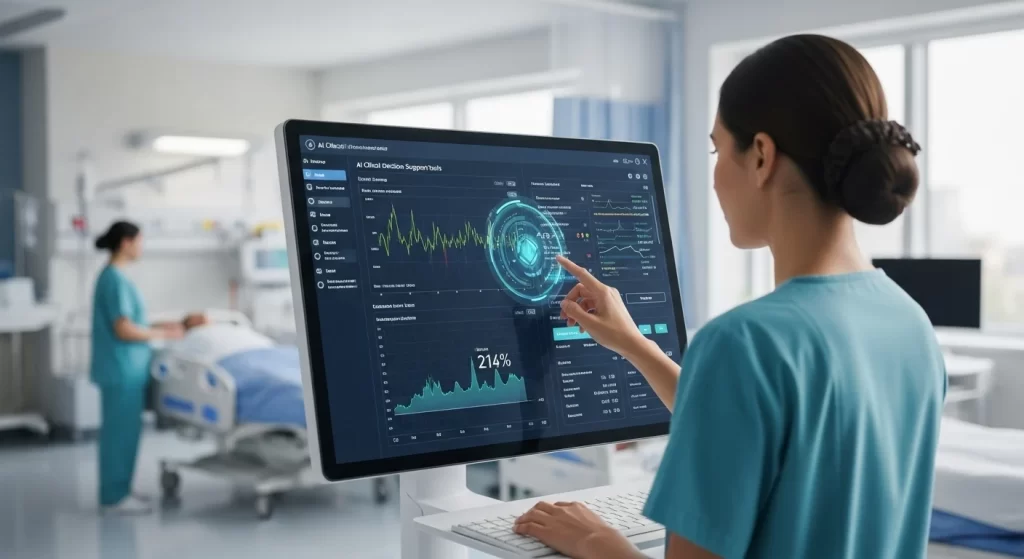Modern healthcare faces escalating complexity. The sheer volume of medical knowledge and patient-specific data presents an unprecedented challenge for clinicians. Conditions like multimorbidity and rare diseases demand diagnostic precision and treatment coordination that strains traditional healthcare models. This intricate landscape adds to the cognitive burden on healthcare professionals, making it increasingly challenging to provide consistent, high-quality care.

Clinicians often find themselves overwhelmed by the fragmentation of electronic health record (EHR) systems, which can impede effective decision-making. This environment leads to diagnostic dilemmas and difficulties in optimizing treatment. AI Clinical Decision Support Systems (CDSS) are emerging as pivotal solutions. These systems are designed to transform healthcare from a largely reactive approach to one that is proactive, enhancing precision and empowering clinicians with real-time, evidence-based insights.
This article explores how AI CDSS addresses these multifaceted challenges, delving into its core mechanisms, tangible benefits, critical implementation considerations, and future trajectory in advancing healthcare.
Ready to empower your clinicians with data-driven insights for even the most complex cases? Explore how our AI for clinical decision support tools can help you!
The Challenges of Complex Cases in Modern Healthcare
Modern healthcare presents a complex array of challenges, particularly in managing intricate patient cases. These difficulties impact diagnostic accuracy, treatment efficacy, and clinician well-being.
Table 1. Key Challenges in Complex Case Management
| Challenge Category | Specific Issues | Impact on Healthcare |
|---|---|---|
| Diagnostic Dilemma | Information Overload & Fragmentation | Increased cognitive burden, clinician burnout, reduced efficiency, potential for medical errors and delays |
| Atypical Presentations & Rare Diseases | Misdiagnosis, delayed treatment, worsening conditions, emotional/financial strain on patients, increased mortality risk, higher healthcare costs | |
| Treatment & Management | Multi-Morbidity & Polypharmacy | Fragmented care, suboptimal outcomes, increased healthcare costs, challenges in integrated care delivery |
| Bridging the Knowledge Gap | Difficulty in staying updated with rapidly evolving medical knowledge, inconsistent application of latest evidence, suboptimal decision-making in complex cases |
The Diagnostic Dilemma
Accurate and timely diagnosis is the bedrock of effective patient care. However, several systemic issues create significant diagnostic dilemmas.

Information Overload and Fragmentation
A vast amount of medical knowledge and patient data characterizes the contemporary healthcare landscape. Fragmented Electronic Health Record (EHR) systems impose a significant cognitive burden on physicians. Clinicians spend a substantial amount of time on EHR tasks, such as documentation, which detracts from direct patient care and critical thinking, potentially decreasing decision-making accuracy. This “data deluge” manifests as mental fatigue, increased stress, and reduced efficiency among healthcare professionals.
Disorganized, unnecessary, or incomplete data in EHRs exacerbates this problem, contributing to higher “extraneous cognitive load” and placing excessive demands on a clinician’s working memory. Traditional data display methods, often organized by episodes of care or data type, place the entire burden of data aggregation and synthesis on the user, leading to inefficiencies and potential oversights.
The cognitive burden experienced by individual clinicians is not an isolated issue; it cascades into systemic inefficiencies, compromises patient safety through errors and delays, and imposes financial strain on healthcare organizations. Delays in care, reduced operational efficiency, and increased turnover are direct consequences of these issues. Addressing clinician cognitive overload is a critical strategic imperative for improving healthcare quality, safety, and long-term economic sustainability.
Atypical Presentations and Rare Diseases
Rare diseases, affecting fewer than 200,000 people in the US or less than 1 in 2,000 in Europe, collectively impact an estimated 300 million individuals worldwide. A significant challenge is the “overlap dilemma,” where symptoms of rare diseases mimic those of common conditions, often leading to incorrect diagnoses.
Key factors contributing to misdiagnosis or delayed diagnosis include:
- Limited physician awareness due to insufficient rare disease representation in medical education.
- Nonspecific or variable symptoms that mimic more common disorders.
- Scarcity of specialized diagnostic tools.
- Fragmented care, where patients consult multiple specialists without a holistic view.
Globally, misdiagnosis delays treatment for an average of 4.8 years for people with rare diseases, worsening their condition and causing emotional distress, financial strain, and unnecessary procedures. Diagnostic errors, more broadly, account for an estimated 60% of all medical errors and may contribute to as many as 80,000 deaths per year in the United States.
The complexity and rarity of these conditions directly lead to diagnostic delays. These delays cause prolonged physical suffering, heightened emotional distress, significant financial burden, reduced quality of life, accelerated disease progression, and increased mortality risk for patients. At the system level, healthcare costs rise due to prolonged treatments, additional tests, and frequent hospitalizations, which strain systems and lead to poorer population health outcomes. Timely and accurate diagnosis, especially for complex and rare conditions, is a critical strategic lever for improving public health, mitigating escalating healthcare expenditures, and advancing health equity.
Optimizing Treatment and Management Pathways
Beyond diagnosis, the complexity of modern patient cases extends to optimizing treatment and management, particularly for individuals with multiple health conditions.
Multi-Morbidity and Polypharmacy Challenges
Multimorbidity, the presence of two or more long-term health conditions, is a significant global challenge, affecting over one in four adults in England and is increasingly common in older and disadvantaged populations. Individuals with multiple conditions often experience reduced mobility, chronic pain, shrinking social networks, work incapacity, and lower mental well-being. Historically, these interconnected issues have been inadequately addressed by services or research, as healthcare systems tend to focus on individual diseases.
Despite calls for integrated, person-centered care, current strategies often fall short of this goal. A common consequence of multimorbidity is polypharmacy, where patients receive numerous medications for long periods, driving increased healthcare costs and resource utilization. Evidence on the effective management of multiple long-term conditions remains sparse, with many interventions showing limited value compared to regular care.
Bridging the Knowledge Gap in Evolving Medicine
Medical knowledge is expanding exponentially, making it challenging for individual clinicians to stay current and effectively integrate the latest research into their practice. This widening knowledge gap hinders the ability to make timely and accurate decisions, especially in complex cases that span multiple specialties or present atypical symptoms. Even with research advances, such as for Urea Cycle Disorders (UCDs), patients and clinicians often lack sufficient data to guide healthcare decisions for complex, chronic illnesses despite improved survival rates. That highlights a critical need for systems that can bridge this knowledge gap and provide actionable insights.
The specialized structure of modern medicine, while excellent for deep expertise in single diseases, struggles with the holistic nature of multimorbidity. That creates tension between comprehensive, integrated care and specialized clinical practice. The AI Clinical Decision Support System, due to its ability to synthesize vast and diverse data across specialties, can act as a knowledge bridge. They support generalists in managing multiple conditions and assist specialists in understanding the broader patient context, mitigating fragmentation and knowledge gaps.
The Core of AI Clinical Decision Support: How Intelligence Powers Precision
AI Clinical Decision Support System fundamentally reshapes how medical professionals approach complex cases by leveraging advanced intelligence to process, analyze, and synthesize vast amounts of data. This intelligence powers precision, offering capabilities far beyond traditional methods.
Table 2. AI Clinical Decision Support Capabilities and Examples
| Capability Area | Description | Examples / Mechanisms |
|---|---|---|
| Intelligent Data Ingestion & Synthesis | ||
| Unlocking Unstructured Data | Extracts meaningful information from clinical notes, patient narratives, etc. | Natural Language Processing (NLP), Named Entity Recognition (NER) |
| Integrating Multi-Modal Data | Combines diverse data types for a holistic patient view. | Data fusion of medical imaging, EHRs, lab results, genomics, wearable data |
| Advanced Analytical & Predictive Capabilities | ||
| Pattern Recognition & Anomaly Detection | Identifies subtle patterns and deviations in complex medical data. | Machine Learning (ML), Deep Learning (DL), Convolutional Neural Networks (CNNs) for image analysis |
| Predictive Modeling | Forecasts future health outcomes and risk stratification. | Identifying AKI risk 48 hours in advance, sepsis mortality reduction (17%), heart disease risk from genomics, CTRCD prediction |
| Delivering Actionable Recommendations & Visualizations | ||
| Evidence-Based Recommendations | Provides patient-specific, guideline-adherent diagnostic and treatment suggestions. | Differential diagnoses, personalized treatment plans, improved adherence to clinical guidelines |
| Interactive Dashboards & Visualizations | Presents complex data in intuitive, real-time visual formats. | Real-time monitoring of vital signs, lab results, adverse events; interactive charts for trend analysis |
Intelligent Data Ingestion and Synthesis
At its core, AI CDSS functions by analyzing vast and diverse datasets, including patient records, medical literature, and clinical guidelines, to generate real-time, actionable insights and recommendations. This process begins with sophisticated data ingestion and synthesis.
Unlocking Insights from Unstructured Data with NLP
Natural Language Processing (NLP), a specialized branch of AI, is instrumental in this process. NLP enables computers to understand, interpret, and generate human language, which is crucial for extracting meaningful information from the large amounts of unstructured clinical data found in doctors’ notes, patient narratives, and pathology reports. Approximately 80% of medical data is unstructured, making natural language processing (NLP) essential for unlocking its value.
NLP automates the extraction and analysis of clinical data, significantly reducing the administrative burden on physicians, who currently spend a considerable portion of their time on documentation and desk work. This automation allows them to redirect their focus to direct patient care. By offering data-driven recommendations based on real-time insights, NLP enhances CDSS, improves clinical documentation, and supports better decision-making and patient safety. For example, Named Entity Recognition (NER) models can accurately identify key medical entities, such as allergies and medications, leading to a substantial reduction in medication errors.
Integrating Multi-Modal and Multi-Source Data
Multimodal AI represents a significant leap forward by integrating various types of medical information, including medical imaging (X-rays, MRIs, CT scans), laboratory test results, comprehensive patient histories, genetic data, wearable device data, and genomic sequencing reports. This approach provides a more complete and holistic view of a patient’s condition. This “data fusion” process combines heterogeneous data sources to produce a more accurate, reliable, and actionable representation of a phenomenon than any individual data source could provide on its own.
AI, particularly by leveraging machine learning and deep learning networks, serves as the computational backbone that processes vast amounts of diverse medical data to derive actionable insights, thereby enhancing diagnostic accuracy and enabling predictive capabilities. Practical applications include combining imaging data, genomic information, and electronic health records (EHRs) to achieve more accurate tumor subtyping, prognosis, and highly personalized therapy in oncology.
The existence of disparate, isolated data sources, often trapped in legacy systems and data silos, inherently prevents a comprehensive understanding of the patient. This fragmentation leads to incomplete patient profiles and suboptimal decision-making. Multimodal AI and advanced data fusion techniques are the direct solution to this fragmentation, enabling the creation of a truly complete picture of a patient’s health.
NLP’s ability to structure unstructured data and data fusion’s capacity to integrate diverse modalities directly address this by facilitating seamless data exchange and synthesis. This fundamental shift from siloed data to integrated, multimodal patient profiles is not just a technical upgrade but a foundational requirement for realizing precision medicine and truly personalized, patient-centric care. It also underscores the critical importance of adopting and enforcing robust interoperability standards, such as Fast Healthcare Interoperability Resources (FHIR), to enable this essential data flow across the healthcare ecosystem.
Advanced Analytical and Predictive Capabilities
Beyond data ingestion, AI CDSS excels in advanced analytical and predictive functions, transforming raw data into foresight.

Pattern Recognition and Anomaly Detection with Machine Learning
AI’s remarkable proficiency in medical diagnosis stems from its ability to mimic human cognition, but with immense computational power and speed, allowing it to learn from extensive medical datasets, including images, records, and guidelines. Machine learning (ML) and deep learning (DL) algorithms are particularly adept at spotting subtle anomalies in medical images, identifying complex trends in patient data, and linking seemingly disparate symptoms to potential conditions.
Deep learning models, especially Convolutional Neural Networks (CNNs), have demonstrated exceptional performance in medical image classification, segmentation, and anomaly detection. That includes tasks such as detecting fractures, tumors, and vascular irregularities, identifying cancerous cells, and analyzing MRI scans for early signs of neurodegenerative diseases. AI can accurately distinguish between benign and malignant tumors, potentially reducing the need for invasive biopsies.
Predictive Modeling for Risk Stratification and Outcomes
A cornerstone of advanced AI CDSS is its predictive capability. AI and predictive decision-making analyze vast amounts of patient data—including genetic information, lifestyle factors, and comprehensive medical history—to identify individuals at high risk for developing specific conditions even before symptoms become apparent. This proactive approach enables earlier interventions, which consistently leads to better patient outcomes and can prevent the progression of serious diseases.
Predictive models can forecast a range of future health outcomes, such as disease progression, patient deterioration, or potential complications, and effectively stratify high-risk patients who are prone to adverse events, including hospital readmissions or emergency department visits. Concrete examples of AI’s predictive power include:
- AI tools that detect acute kidney injury (AKI) risk up to 48 hours before clinical signs emerge, leading to reduced ICU days.
- Models that predict sepsis mortality are associated with a 17% reduction.
- Systems that identify heart disease risk using genomic scoring.
- AI aids in predicting cardiotoxicity in cancer patients (CTRCD) by analyzing ECG and echocardiography data.
AI’s ability to predict health issues before symptoms manifest or before they escalate significantly contrasts with the traditional reactive model of healthcare, where interventions typically occur after a problem has fully developed.
The core benefit is the enablement of earlier interventions and the prevention of serious diseases. AI’s advanced pattern recognition and sophisticated predictive modeling enable it to identify subtle risk factors, nascent trends, and early indicators that human clinicians, due to cognitive limitations or data fragmentation, may easily overlook. This foresight enables a fundamental and transformative shift in both the timing and nature of medical intervention.
Delivering Actionable Recommendations and Visualizations
The ultimate goal of AI CDSS is to translate complex analyses into practical, actionable guidance for clinicians.
Evidence-Based Recommendations and Differential Diagnoses
AI CDSS empowers clinicians by providing real-time predictive data, evidence-based recommendations, and comprehensive risk assessments. That is achieved by meticulously analyzing patient-specific information and vast repositories of medical literature. These systems can generate comprehensive lists of possible diagnoses (differential diagnoses) and suggest optimal recommended tests or treatment plans, all tailored to the individual patient’s medical history and incorporating the latest medical studies and guidelines.
AI CDSS has been shown to significantly improve adherence to clinical guidelines, demonstrating its substantial potential in more effectively managing long-term conditions and ensuring consistent quality of care. While generative AI models exhibit promising diagnostic capabilities, particularly advanced models like GPT-4, they have not yet consistently achieved the reliability of expert physicians in all contexts. That underscores the ongoing importance of human oversight and judgment. However, studies consistently show that human-AI collaboration significantly increases diagnostic accuracy, often outperforming either humans or AI operating alone.
Interactive Dashboards and Visualizations
AI-powered dashboards and data visualization tools transform the understanding of complex medical data, converting it into intuitive, easy-to-understand visual formats, such as interactive charts, graphs, and heat maps. These tools provide immediate insights, forecasts, and even automated treatment plans, enabling faster and more accurate decisions, especially in critical or emergency scenarios.
Interactive dashboards allow clinical researchers and practitioners to monitor study progress, track patient enrollment, analyze safety parameters (e.g., vital signs, laboratory results, adverse events), and visually analyze trends and biomarkers in real time, all without requiring specialized programming expertise. These visualizations also enhance communication among healthcare teams and with patients, simplifying complex information and promoting shared decision-making. Customized views can ensure that healthcare experts see data most relevant to their specific roles, improving overall staff efficiency and patient care.
From Insights to Impact: The Transformative Benefits of AI Clinical Decision Support
The integration of AI into clinical decision support systems is not merely a technological advancement; it is a profound transformation that delivers tangible benefits across the healthcare ecosystem, from enhancing diagnostic accuracy to improving clinician well-being.
Table 3. Quantifiable Benefits of AI in Clinical Practice
| Benefit Category | Specific Impact | Quantifiable Evidence / Examples |
|---|---|---|
| Diagnostic Accuracy & Speed | Improved Diagnostic Accuracy | AI-CDSS achieved 94% accuracy in breast cancer detection (vs. 88% traditional), 89.7% overall diagnostic accuracy (vs. 73.8% baseline). Human-AI groups outperformed 85% of human diagnosticians. |
| Reduced Diagnostic Errors & Delays | AI detects AKI risk 48 hours prior, reducing ICU days by 1.2 per patient. Sepsis prediction models associated with 17% reduction in mortality. | |
| Faster Diagnosis Times | Diagnosis times for TB/lung cancer are cut from days to hours. Stroke detection via CT scans in minutes. | |
| Treatment & Patient Safety | Personalized Treatment Plans | AI-driven insulin dosing reduced hypoglycemic episodes by ~40% in Type 1 Diabetes. |
| Minimized Adverse Events & Drug Interactions | Named Entity Recognition (NER) models achieved 87.28% accuracy in detecting prescription errors. AI can predict potential adverse drug reactions. | |
| Clinician Efficiency & Well-being | Reduced Cognitive Load & Burnout | Ambient AI scribes positively impacted physician cognitive demand (100% positive comments), temporal demand (62%), work-life integration (91%), and overall workload (89%). 40% relative reduction in burnout reported by providers using ambient documentation tools. |
| Streamlined Workflows & Productivity | Automation of documentation and data entry, freeing clinicians for direct patient care. AI-enabled hospitals report 30-40% improvement in workflow efficiency. | |
| Cost Savings | Reducing diagnostic errors can save healthcare systems $20–30 billion annually. Remote patient monitoring can lower hospitalization costs by 25–30%. Large health systems report $50M+ annual savings from AI operational efficiencies. |
Elevating Diagnostic Accuracy and Speed
One of the most critical impacts of AI CDSS is its ability to refine and accelerate the diagnostic process.

Reducing Diagnostic Errors and Delays
AI serves as a promising safeguard against diagnostic errors, offering an extra layer of scrutiny and impartiality in the diagnostic process. In high-pressure environments, such as the emergency department, where rapid decisions are made with limited information and under cognitive overload, AI offers crucial solutions. It streamlines information gathering by automating data retrieval and summarizing relevant patient information, thereby reducing cognitive load and providing clinicians with essential patient details quickly and efficiently.
AI-driven CDSS enhances diagnostic decision-making by offering real-time insights, reducing cognitive biases, and prioritizing differential diagnoses. This capability is particularly well-suited to reducing diagnostic errors because AI can rapidly process vast amounts of patient data, identify subtle patterns that may elude human clinicians, and learn from past diagnostic mistakes.
Unlike humans, AI systems are not susceptible to fatigue or biases, resulting in fewer diagnostic errors. Studies demonstrate that AI algorithms can match or exceed the accuracy of experienced human experts; however, AI should be seen as a complementary tool rather than a replacement. Human-AI collaboration has been shown to significantly increase diagnostic accuracy, often outperforming either humans or AI alone.
Supporting Complex and Rare Disease Identification
AI-powered solutions are transforming the diagnosis and treatment of rare diseases by leveraging machine learning (ML), natural language processing (NLP), and deep learning models. Tools like FindZebra, an AI-powered search engine, utilize NLP to comprehend clinical descriptions and match patient symptoms with potential rare conditions from extensive medical literature databases, providing ranked lists of possibilities along with supporting evidence. The Undiagnosed Diseases Network (UDN) utilizes AI-driven tools to compare individual patient cases with a global database of rare diseases, identifying similarities even when presentations are complex or incomplete.
AI-assisted symptom recognition and pattern matching analyze vast amounts of medical data to identify complex symptom patterns indicative of rare diseases. Furthermore, AI in rare disease diagnosis serves as an assistant in integrating and examining diverse data, effectively supporting medical practitioners by providing a list of relevant differential diagnoses. AI can also identify rare disease patterns utilizing Bayesian comorbidity networks, which can differentiate and group subtypes of both rare and non-rare diseases, contributing to a better understanding of the disease. These capabilities accelerate diagnosis, improve accuracy, and expand treatment options for conditions that previously went unrecognized.
Optimizing Treatment Pathways and Patient Safety
AI CDSS extends its transformative impact to treatment optimization, ensuring personalized care and enhanced patient safety.

Personalized and Precision Treatment Plans
The integration of AI has ushered in a new era of personalized medicine, promising more effective and tailored treatments for patients. Traditional medical approaches often employ a one-size-fits-all model. Still, AI-powered personalized medicine alters this by leveraging the power of data, machine learning, and advanced analytics to create individualized healthcare plans tailored to each patient.
AI plays a pivotal role by processing vast amounts of patient data, identifying patterns, and generating insights that aid in diagnosis, treatment selection, and prognosis. That includes analyzing an individual’s genetic makeup to predict disease susceptibility, select targeted therapies, and even predict the likelihood of treatment success. AI can analyze patient data to identify the most suitable treatment options, including drug dosages and therapy regimens, ensuring that treatments are tailored to an individual’s unique needs and improving both effectiveness and patient compliance.
For example, AI-powered platforms can generate treatment plans tailored to each patient’s unique needs, taking into account their specific backgrounds and symptoms. They can help set SMART (Specific, Measurable, Achievable, Relevant, Time-bound) goals. In precision oncology, AI is transforming cancer care by providing innovative approaches to customize cancer treatments, improving diagnostic accuracy, predicting treatment outcomes, minimizing toxicities, and enhancing patient survival rates. AI tools, such as IBM Watson for Oncology, evaluate genetic information and medical research to aid in cancer diagnosis, detect DNA mutations, and suggest tailored treatment options.
Minimizing Adverse Events and Drug Interactions
AI significantly contributes to medication safety by helping doctors determine the correct dosage and flagging potential drug interactions, thereby reducing the risk of errors. Medication errors cause patient harm and increase healthcare costs, including hospitalizations and other adverse outcomes. AI can identify and prevent these errors by analyzing patient data, predicting drug interactions, and providing real-time alerts. Machine learning algorithms can analyze large datasets of patient information, including clinical guidelines, clinical trials, and postmarketing surveillance, to predict adverse reactions and optimize treatment plans.
By combining machine learning with pharmacogenomics and ongoing pharmacovigilance, AI can effectively predict potential adverse drug reactions in patients. AI models also play a promising role in predicting adverse events, offering potential for clinical decision support. These systems can identify potential health threats or issues in advance, enabling timely intervention to prevent complications.
Enhancing Clinician Efficiency and Reducing Cognitive Load
AI CDSS tools are designed to alleviate the overwhelming burden of data overload and complex cases on clinicians.
Streamlined Information Synthesis
AI offers a pathway to alleviate this burden by automating routine tasks, streamlining workflows, and providing rapid access to critical information, thereby freeing up clinicians to focus on direct patient care and complex problem-solving. AI-powered systems can instantly sift through millions of patient records, the latest research papers, and diagnostic images, offering insights and probabilities that would take a human clinician weeks, if not months, to uncover. This intelligent clinical workflow automation allows clinicians to dedicate more time to patient interactions.
Improved Productivity and Reduced Burnout
Organizations implementing AI in clinical decision support report faster diagnoses, reduced errors, and significant cost savings. For example, AI algorithms trained on medical images can match the diagnostic accuracy of pathologists while delivering results significantly faster, drastically reducing patient waiting times. AI tools can also cut diagnosis times for conditions like tuberculosis and lung cancer from days to mere hours, even in remote areas.
AI CDSS helps reduce workforce pressure by providing clinicians with precise, timely recommendations, saving time and reducing decision fatigue. Qualitative studies have found that ambient AI scribes, which transcribe conversations and generate draft clinical notes in real time, have a positive impact on physician workload, work-life integration, and patient engagement. Physicians reported positive sentiments about the impact on:
- Cognitive demand (100% of comments).
- Temporal demand (62%).
- Work-life integration (91%).
- Overall workload (89%).
Nearly 80% of physicians using these tools reported that they were able to pay more attention to patients during visits, demonstrating that technology can indeed enhance patient-provider interaction. That contributes to resolving healthcare staffing shortages and enhancing the overall well-being of clinicians.
The Future Horizon: Advancing Healthcare with AI Clinical Decision Support
The trajectory of AI in healthcare points towards an increasingly sophisticated and integrated future, promising even greater precision, proactive care, and global accessibility.

Enhanced Precision and Proactive Care
The evolution of AI CDSS is set to deliver healthcare that is not only more accurate but also deeply personalized and anticipatory.
Hyper-Personalized Diagnostics and Treatment
The future of AI-driven CDSS will provide clinicians with more accurate and personalized diagnostic and treatment recommendations, supporting continuous patient monitoring and follow-up care. AI is already enabling tailored treatments based on individual patient factors, such as genetics, lifestyle, and medical history.
As AI technology advances, more precise and personalized treatment recommendations are expected, enhancing patient outcomes and satisfaction. This hyper-personalization will extend beyond current capabilities, leveraging increasingly rich datasets, including real-time physiological data and continuous genomic analysis, to fine-tune interventions to an unprecedented degree.
Predictive and Prescriptive Analytics for Early Intervention
Predictive analytics, powered by AI, will continue to evolve, allowing healthcare providers to detect patterns, anticipate risks, and intervene early, thereby improving outcomes, reducing errors, and cutting costs. This shift from reactive to proactive care will be further enhanced by prescriptive analytics, which suggests specific actions derived from data analysis, thereby optimizing operations such as staffing, resource allocation, and care pathways.
AI models will monitor patient vitals, lab results, and clinician notes in real time to detect subtle indicators of illness before they escalate, resulting in faster alerts and improved patient health outcomes. The ability to identify high-risk individuals before symptoms appear or early in the disease course and pinpoint which risk factors matter most at different life stages will allow for more targeted and effective preventive strategies.
Expanding Scope and Collaboration
The future of AI CDSS also involves a broader application across public health and a collaborative global effort.
Supporting Population Health and Public Health
AI-driven CDSS can significantly contribute to achieving public health goals by enhancing healthcare equity, reducing workforce pressure, supporting preventive care initiatives, streamlining crisis response, and improving clinical outcomes through standardization. By aggregating real-time data, governments can detect emerging health threats earlier, respond more effectively, and allocate resources more efficiently during public health emergencies. Predictive analytics embedded in CDSS can provide warnings of potential crises, ensuring healthcare systems are better equipped to respond.
Data analytics, combined with artificial intelligence (AI), is crucial for effective population health management. It helps identify at-risk populations, anticipate the need for timely preventive actions, and manage chronic conditions by identifying high-risk groups and devising targeted intervention strategies. AI can also help identify care gaps and evaluate health inequalities, working toward fair healthcare delivery and increasing healthcare equity across diverse populations.
Global Accessibility and Democratization of Expertise
AI promises to enhance accurate diagnoses, streamline care delivery, and expand access to health services worldwide, particularly in underserved regions. The swift progress in AI models, improved algorithms, and hardware innovation has notably enhanced AI accessibility and lowered the costs associated with its adoption and implementation, allowing a broader spectrum of users to leverage its capabilities. That includes adapting AI for underserved regions through multilingual support and cost-effective deployment strategies, helping to bridge the digital divide.
AI can enhance access to quality care for medically vulnerable communities and patients by enabling remote monitoring of micro-health data. By analyzing large datasets to identify patterns and insights, AI can enhance diagnostics, strengthen early disease detection, and design personalized treatment plans, even in areas with limited access to specialized medical professionals. However, ensuring the accessibility of required infrastructure (high-speed broadband, energy, data) is crucial for implementing AI in these communities.
Evolving Regulatory Frameworks and Cross-Sector Collaboration
The rapid integration of AI into healthcare necessitates adaptive regulatory models that address algorithmic bias, data privacy, and equitable access while fostering innovation through international collaboration, regulatory sandboxes, and public-private partnerships. Regulatory developments in the US (e.g., the FDA’s AI guidelines), the UK, and the EU (e.g., the EU AI Act) have set prominent benchmarks; however, significant innovation and diverse regulatory strategies are evolving rapidly across Asia, Africa, and South America.
Universal themes consistently shared across regulatory frameworks include ethical considerations (such as fairness, transparency, and accountability), as well as data privacy and protection. Regulators worldwide are continually adapting to technological advancements while collaborating internationally on common challenges, such as algorithmic bias and accountability deficits and ensuring AI works effectively across diverse populations without exacerbating existing disparities. This evolving landscape requires continuous evaluation and adjustments to regulatory frameworks to ensure the ethical, safe, and effective use of AI in CDSS.
Conclusion
The journey from raw data to precise diagnosis in complex case management is undergoing a profound transformation, driven by the revolutionary capabilities of a robust AI Clinical Decision Support System. The challenges posed by information overload, fragmented healthcare systems, the intricacies of rare diseases and multimorbidity, and the ever-expanding medical knowledge base have created significant pressures on clinicians, compromising patient outcomes.
AI CDSS offers a powerful antidote to these complexities. By intelligently ingesting and synthesizing vast, multi-modal, and often unstructured data through advanced Natural Language Processing and data fusion techniques, these systems unlock insights previously unattainable. Their advanced analytical and predictive capabilities, powered by machine learning and deep learning, enable unprecedented pattern recognition, anomaly detection, and risk stratification. The delivery of evidence-based recommendations, differential diagnoses, and intuitive interactive visualizations empowers clinicians with real-time, actionable intelligence.
Looking to the future, AI CDSS promises even greater precision and proactive care, with advancements toward hyper-personalized diagnostics, sophisticated predictive and prescriptive analytics, and integration with transformative technologies like digital twins. Its expanding scope will increasingly support population health initiatives, enhance global accessibility, and democratize medical expertise, all within an evolving framework of international regulatory collaboration.
The era of intelligent healthcare is rapidly unfolding. For healthcare organizations seeking to navigate the complexities of modern medicine and deliver superior patient outcomes, embracing AI Clinical Decision Support is no longer optional. It is the pathway to a more precise, efficient, and equitable future of care.
Don’t let the complexity of healthcare overwhelm your clinical team. Partner with SPsoft to leverage the power of AI clinical decision support, transforming data into precise diagnoses and optimal patient outcomes!
FAQ
Why are complex medical cases so hard to diagnose today?
Diagnosing complex cases is challenging due to a “data deluge” from fragmented electronic health records (EHRs), which overwhelms clinicians. Rare diseases often mimic common ones, leading to an average diagnostic delay of 4.8 years. Furthermore, managing patients with multiple chronic conditions (multimorbidity) is complex because healthcare is often structured around single diseases, making a holistic view nearly impossible for one doctor to achieve.
How can AI possibly understand a doctor’s messy notes?
AI uses a technology called Natural Language Processing (NLP) to read, interpret, and structure the information hidden in doctors’ notes, patient narratives, and reports. Since approximately 80% of medical data is unstructured, NLP is essential. It automatically extracts key details, such as allergies and medications, which can significantly reduce documentation errors and free up clinicians to focus more on patient care.
Can AI diagnose diseases better than a human doctor?
While AI isn’t meant to replace doctors, it significantly boosts their diagnostic power. Studies show that human-AI collaboration outperforms either human or AI alone. For example, an AI-CDSS achieved 94% accuracy in breast cancer detection compared to 88% for traditional methods. AI can also detect subtle patterns humans might miss, flagging risks like acute kidney injury up to 48 hours before clinical signs emerge.
What is “multimodal AI” and why is it important in healthcare?
Multimodal AI is a powerful approach that combines, or “fuses,” different types of patient data—such as medical images (X-rays, MRIs), lab results, genetic information, and EHR notes—to create a single, holistic view of a patient’s health. That is critical for moving beyond siloed information, enabling more accurate diagnoses and personalized treatment plans, particularly in complex fields such as oncology.
How does AI help with the “one-size-fits-all” problem in medicine?
AI is the engine behind personalized medicine. By analyzing a patient’s unique genetic makeup, lifestyle, and medical history, AI can help tailor treatment plans specifically to their needs. For instance, AI can suggest optimal drug dosages, predict which therapies will be most effective, and even help set personalized health goals. That moves healthcare away from generic approaches to truly individualized care, improving effectiveness and patient compliance.
Will using AI decision support add more work for busy clinicians?
No, the goal is the opposite. AI is designed to reduce the cognitive load and burnout that clinicians face. It automates routine tasks, streamlines information gathering, and presents complex data in intuitive dashboards. Ambient AI scribes, which automatically generate notes from conversations, have been shown to positively impact workload and work-life integration for 91% of physicians, allowing them to focus more on patient care.
How does AI improve patient safety?
AI enhances patient safety by reducing errors and minimizing adverse events. It can analyze a patient’s data to flag potential drug interactions or predict adverse reactions before a prescription is even written. For instance, AI models have achieved an accuracy rate of over 87% in detecting prescription errors. By providing an extra layer of scrutiny, AI acts as a crucial safeguard, especially in high-pressure medical environments.
Can AI help find a diagnosis for rare diseases faster?
Yes, this is a key strength of AI. For rare diseases, which can take nearly five years to diagnose, AI tools act like powerful search engines. They can analyze a patient’s symptoms and compare them against global databases of rare conditions, providing doctors with a ranked list of potential diagnoses. That accelerates the diagnostic process, reduces patient suffering, and enables earlier and more effective treatment.
What is the future of AI in clinical decision-making?
The future is hyper-personalized and proactive. AI will move beyond just predicting risk to prescribing specific actions to prevent illness. We can expect more sophisticated systems that monitor patient data in real-time to continuously fine-tune treatments. AI will also play a larger role in public health by analyzing population-level data to detect disease outbreaks and address health inequities on a global scale.
How much money can AI save a hospital?
The financial benefits are significant. AI helps reduce costly diagnostic errors, which could save healthcare systems between $ 20 billion and $ 30 billion annually. It also improves operational efficiency; AI-enabled hospitals report a 30-40% improvement in workflows. Some large health systems have reported annual savings of over $50 million from these AI-driven operational efficiencies, demonstrating that it’s a sound investment for a sustainable healthcare future.



